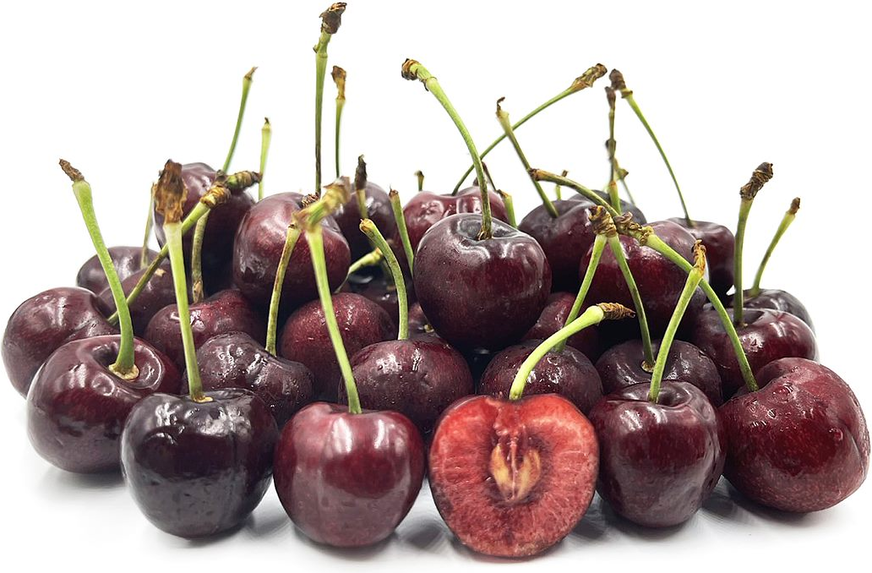


Sweetheart Cherries
Estimated Inventory, lb : 0
Description/Taste
Sweetheart cherries are a small to medium-sized varietal and have a uniform, cordate shape with curved shoulders that taper slightly to a rounded base. The fruit’s skin is smooth, glossy, taut, and thin, showcasing a bright red to dark red, almost black hue. The cherries are also attached to elongated green stems that are semi-thick and fibrous. Underneath the surface, the flesh is dense, aqueous, and bright red with a firm consistency. The flesh also encases a central tan pit that is inedible and should be discarded. Sweetheart cherries have a very sweet taste balanced with mildly acidic undertones, creating a pleasant, sweet, and tangy flavor.
Seasons/Availability
Sweetheart cherries are available in mid to late summer.
Current Facts
Sweetheart cherries, botanically classified as Prunus avium, are a late-season cultivar belonging to the Rosaceae family. The sweet fruits grow on trees that can reach 2 to 3 meters in height and are a modern cherry variety developed in Canada in the late 20th century. Sweetheart cherries were specifically designed to come into season when other cherry varieties leave commercial markets, allowing the fruits to be exported globally. Growers also favor the cherries for their high yields, sweet and tangy flavor, and resistance to cracking. In home gardens, Sweetheart cherries are self-fertile and do not require other trees for pollination. The trees are also planted for ornamental use, producing pink and white flowers in the spring, fruits in the summer, and orange and red foliage in the fall.
Nutritional Value
Sweetheart cherries contain anthocyanins, pigments found in the skin and flesh that give the fruit their dark purple-red coloring. These pigments have antioxidant-like properties to reduce inflammation and protect the cells against free-radical damage. The fruits are also a source of vitamins A and C to boost the immune system, increase collagen production within the skin, and maintain healthy organ functioning, and contain potassium to balance fluid levels within the body, calcium to strengthen bones and teeth, and iron.
Applications
Sweetheart cherries have a sweet and tangy flavor well suited for fresh eating. The fruits can be consumed straight, out of hand, discarding the pit, or they can be used as edible decorations on cakes, tarts, and ice cream. Sweetheart cherries can also be sliced and tossed into salads, mixed into grain bowls, stirred into yogurt, blended into smoothies, or juiced for lemonade, fruit punches, and cocktails. In addition to fresh preparations, Sweetheart cherries can be cooked into jams, jellies, and compotes, or they can be simmered into syrups and sauces for roasted meats. The fruits can also be baked into pies, tart, cobblers, and crisps, or they can be stuffed with savory herbs and aromatics into a duck, turkey, or pork. Sweetheart cherries pair well with cheeses such as feta, brie, mascarpone, and burrata, nuts including pistachios, almonds, and pecans, vanilla, chocolate, caramel, and berries such as blackberry, blueberry, and raspberry. Whole, unwashed Sweetheart cherries will keep up to one week when stored between paper towels in the coldest part of the refrigerator. The fruits can also be frozen in a sealed plastic bag for extended use.
Ethnic/Cultural Info
The Summerland Research and Development Center, or Summerland RDC, was established in 1914 and featured a 4,500-square-foot greenhouse for research trials and breeding. Cherries were once a small crop grown in the Okanagan Valley, but as Summerland RDC was funded in 1936 for cherry research, the industry has since expanded to produce and export millions of dollar’s worth of cherries. Experts report that 80% of the commercial cherry varieties found in global markets were initially developed through the Summerland RDC, and the center developed the first self-fertile variety, stella, in the late 20th century. Each cherry variety is trialed through several stages over many years, beginning as one tree and gradually increasing to a whole commercial orchard with 50 trees kept at the Summerland RDC. Sweetheart cherries were later developed in the 1990s and are considered one of the most important varieties that was created at the center. Legend has it that the original Sweetheart cherry tree is still alive and growing at the center in the present day. Local Okanagan Valley growers favor the late-season variety for commercial export to Asia, Europe, and the United States. The cultivar was designed to strategically come into season after Washington State’s cherries are finished for the season, creating an open market for increased international sales.
Geography/History
Sweetheart cherries were developed at the Summerland Research and Development Center, a breeding and research facility located in the Okanagan Valley of British Columbia. The variety was selected from a cross between new star and van cherry varietals and was chosen for its late-season maturity, high yields, and sweet, subtly tart flavor. Sweetheart cherries were bred by David Lane and were released to commercial markets in the early 1990s. Today Sweetheart cherries are cultivated in Canada, the United States, and the United Kingdom and are exported from British Columbia to other regions of Europe, Asia, and the United States.
Recipe Ideas
Recipes that include Sweetheart Cherries. One
| The Complete Savorist |
|
Balsamic Cherries and Ricotta |
| Li'l Vienna |
|
Cherry Chutney |
| Entirely Taylor |
|
Lemon Cherry Cheesecake |
Podcast




